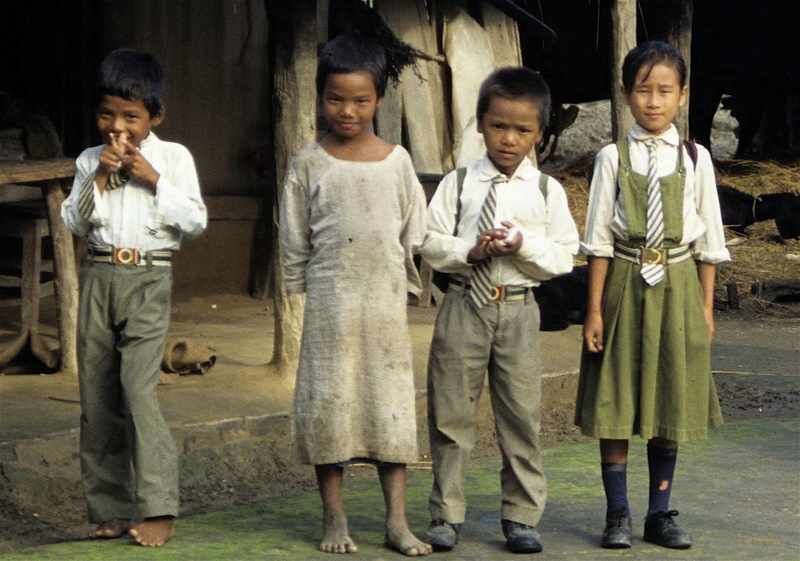
Figure 1.--Here we see Nepalise children, three of whom are wearing their British-styled school uniforms. The girl without the uniform probably does not attend school. |

|
Nepal is a small Himalayan country wedged between India and Tibet. It was controlled by the Gurkas when the British seized control of India (18th century). Nepal signed treaties with the British, but Nepal was never incorporated into the British Raj or colonized by the British. Nepal througout its history has never been conquered by an outside power. Britain recognized the country's complete independence (1923). Nepal because of its lack of coastline and high mountains, it has led an extremely isolated national life. Widespread School attendance is a modern phenomenon and heavily influenced by British connections. The first modern school was set up for the ruling family and court (1851). Few commoners received an educatiion only after a popular movement led to the end of the autocratic Rana family regime and the adoption of a democratic system (1951). School is now required for all Nepalese children between 6-10 years of age. School attendance is becoming widely accepted for boys, but it Nepal's conservative society are reluctant to send their girls to school. The annual enrollment in primary schools was about 1.9 million and in secondary schools about 0.5 million (1980s). Because widespread public education is still relatively new and many girls do not extend school, the country's adult (age 15 and older) literacy rate is only about 50 percent, but this is a substantisl increase from earlier levels. Nepal's principal tertiary educational institution is Tribhuvan University in Kathmandu (1959). We note children wearing school uniforms with an obviously British look.
Nepal is a small Himalayan country wedged between India and Tibet. Nepal because of its lack of coastline and high mountains, it has led an extremely isolated national life. The Nepalese are primarily Hindu with a Buddist minority and small numbers of Muslims. Nepal was dominated by the Gurka (18th century). The first treaty was signed withbthe British (1792). Nepal signed treaties with the British, but Nepal was never incorporated into the British Raj or colonized by the British. The British recruited Gurkas for military service. Nepal througout its history has never been conquered by an outside power. The British recognized the kingdom's full soverignity (1923). Actual power was in the hands of the Rama family from which premiers were chosen. A revolt resulted in shifting power to the formerly figurehead monarchy (1951). The King proclaimed a new constitution with a bicameral legislature which chose the premier.
Widespread School attendance is a modern phenomenon and heavily influenced by British connections. The first modern school was set up for the ruling family and court (1851). Few commoners received an educatiion only after a popular movement led to the end of the autocratic Rana family regime and the adoption of a democratic system (1951).
School attendance is now required for all Nepalese children between 6-10 years of age. School attendance is becoming widely accepted for boys, but it Nepal's conservative society are reluctant to send their girls to school. The annual enrollment in primary schools was about 1.9 million and in secondary schools about 0.5 million (1980s). Because widespread public education is still relatively new and many girls do not extend school. More girls are attending schools, but female enrollment lags far behind thst of males.
The country's adult (age 15 and older) literacy rate is only about 50 percent, but this is a substantisl increase from earlier levels. Nepal's principal tertiary educational institution is Tribhuvan University in Kathmandu (1959).
We note both state and religious schools in Nepal. We are not sure to what extent religion is permitted in the state schools. Nepal is a secular state under some times described as an Hindu Kingdom, although Hindism is not a state religion. There are minority groups, including Tibetian Budhists. The Interim Constitution provides for freedom to practice one's religion, and this is generally the case although despite widespread tolerance, a range of incidents have been reported. The act of convering another person is illegal, although not conversion itself. In additionto the state public schools, there are also traditional Hindu schools in Nepal, just like in India.
We note children wearing school uniforms with an obviously British look.
Related Chronolgy Pages in the Boys' Historical Web Site
[The 1900s]
[The 1910s]
[The 1920s]
[The 1930s]
[The 1940s]
[The 1950s]
[The 1960s]
[The 1970s]
[The 1980s]
[The 1990s]
[The 2000s]
Related Style Pages in the Boys' Historical Web Site
[Long pants suits]
[Knicker suits]
[Short pants suits]
[Socks]
[Eton suits]
[Jacket and trousers]
[Blazer]
[School sandals]
[School smocks]
[Sailor suits]
[Pinafores]
[Long stockings]
Navigate the Boys' Historical Clothing Web Page
[Return to the Main school uniform Asian country page]
[Return to the Main Nepal page]
[Introduction]
[Activities]
[Biographies]
[Chronology]
[Clothing styles]
[Countries]
[Girls]
[Topics]
[Bibliographies]
[Contributions]
[FAQs]
[Glossaries]
[Images]
[Links]
[Registration]
[Tools]
[Boys' Clothing Home]
